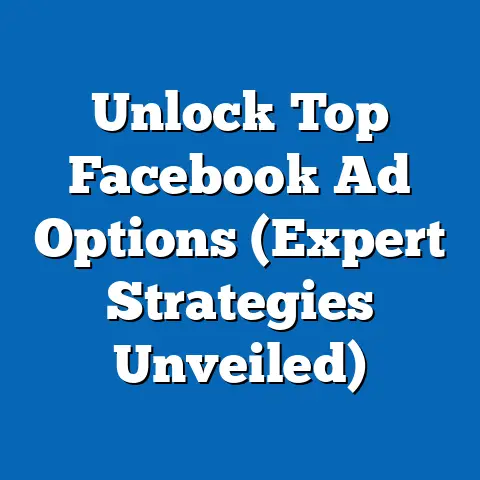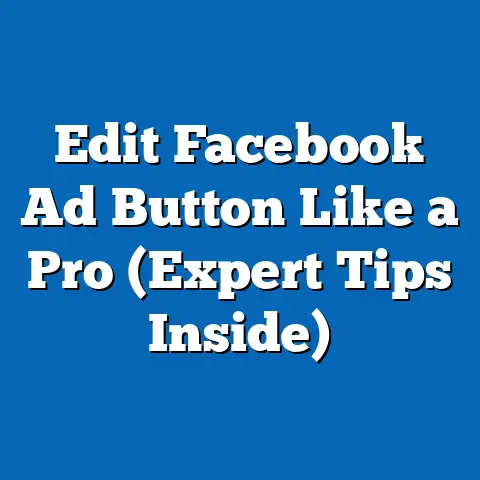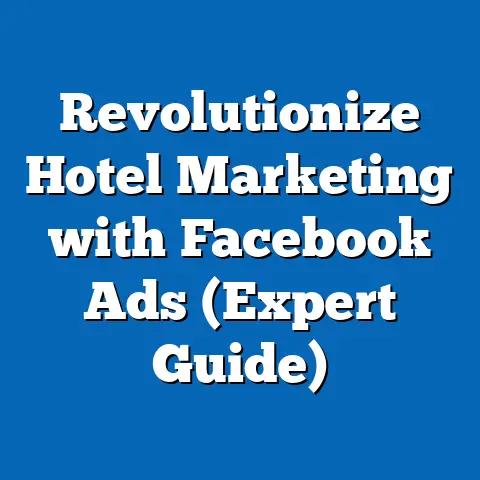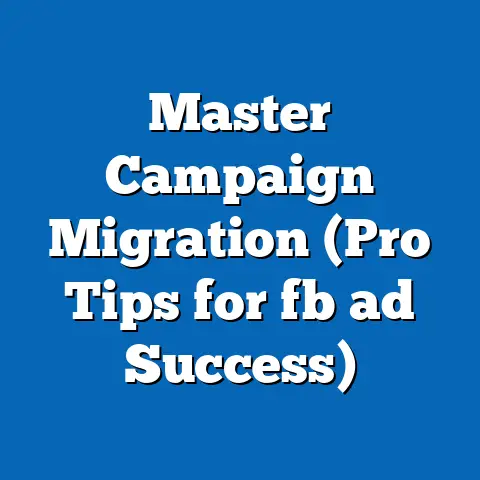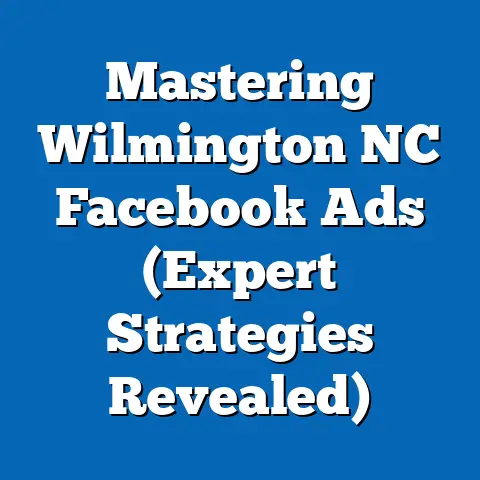Stop Complaining About Facebook Ads (Pro Strategies Revealed)
“Facebook ads don’t work!” How many times have I heard that? Probably hundreds. Maybe even thousands. It’s a common refrain from business owners and marketers who’ve dipped their toes into the Facebook advertising waters, only to find themselves struggling against the current. They complain about low engagement, exorbitant costs, ineffective targeting, and a general feeling of throwing money into a black hole. I get it. I’ve been there.
I remember the early days of my own Facebook advertising journey. I was running a small e-commerce store selling handmade jewelry. I thought, “Hey, everyone’s on Facebook, so this should be easy!” I threw up a few ads with pretty product photos and generic captions, set a budget, and waited for the sales to roll in. Crickets. Complete silence. I felt like I was shouting into the void. Frustrated and discouraged, I almost gave up.
But I didn’t. I knew that Facebook, with its billions of users, had to hold potential. So, I started digging deeper, learning the nuances of the platform, experimenting with different strategies, and analyzing the data. What I discovered was that Facebook advertising, when done right, is an incredibly powerful tool. It’s not a magic bullet, and it certainly requires effort, but it can deliver remarkable results.
The truth is, complaining about Facebook ads is easy. It’s a convenient way to deflect blame and avoid the hard work of understanding the platform. But it’s also unproductive. Instead of focusing on what’s not working, we need to shift our mindset and focus on what can work.
So, if you’re tired of complaining about Facebook ads and ready to start seeing real results, buckle up. This is your guide to unlocking the power of Facebook advertising and transforming it from a source of frustration into a powerful tool for growth. Let’s dive in!
Key Takeaway: Stop focusing on the problems and start focusing on the solutions. With the right strategies and a willingness to learn, Facebook advertising can be a game-changer for your business.
Section 1: Understanding the Facebook Ads Landscape
Before you can master any game, you need to understand the playing field. Facebook’s advertising ecosystem is a complex and ever-evolving landscape, so let’s break it down.
First, let’s talk about reach. Facebook boasts billions of active users worldwide, making it a massive platform for reaching potential customers. Think about it: your target audience is almost certainly on Facebook. The sheer scale of the platform provides unparalleled opportunities for brand exposure and customer acquisition.
But reach alone isn’t enough. You also need to understand the demographics of Facebook’s user base. While Facebook is popular across all age groups, there are nuances to consider. For example, younger demographics might be more active on Instagram (which is owned by Meta, Facebook’s parent company), while older demographics might be more prevalent on Facebook itself. Understanding these demographic shifts is crucial for tailoring your ad campaigns effectively.
Then there are the ad formats. Facebook offers a wide array of ad formats, from simple image ads to engaging video ads, interactive carousel ads, and lead generation forms. Each format has its strengths and weaknesses, and the best choice depends on your objectives and target audience.
For example, I once ran a campaign for a local bakery using video ads showcasing their delicious pastries. The videos were visually appealing and mouthwatering, and they generated a significant amount of engagement and foot traffic to the bakery. On the other hand, I’ve also seen lead generation ads work wonders for businesses offering services like home remodeling or financial planning.
Now, let’s address some common myths and misconceptions surrounding Facebook ads. One prevalent myth is that Facebook ads only work for certain industries. I’ve seen successful Facebook ad campaigns for businesses ranging from local restaurants and boutiques to tech startups and professional service providers. The key is not the industry itself, but the strategy and execution.
Another misconception is that Facebook ads are too expensive for small businesses. While it’s true that you can spend a lot of money on Facebook ads, you don’t have to. You can start with a small budget and gradually scale up as you see results. The beauty of Facebook advertising is that it allows you to target your audience precisely, minimizing wasted ad spend.
Finally, let’s talk about the Facebook algorithm. This is the invisible force that determines which ads are shown to which users. Understanding how the algorithm works is crucial for maximizing your ad performance. The algorithm considers various factors, including the relevance of your ad to the user, the quality of your ad, and the bidding strategy you’ve chosen.
In essence, the Facebook algorithm rewards ads that are engaging, relevant, and provide value to the user. This means that you need to focus on creating high-quality content that resonates with your target audience.
Key Takeaways:
- Facebook offers unparalleled reach and diverse ad formats.
- Don’t fall for common myths about Facebook ads. They can work for any industry with the right strategy.
- Understanding the Facebook algorithm is crucial for maximizing ad performance.
- Focus on creating high-quality, engaging content that provides value to your target audience.
Section 2: Setting Clear Objectives
Imagine setting out on a road trip without a destination in mind. You might enjoy the scenery along the way, but you’re unlikely to reach a specific goal. The same principle applies to Facebook advertising. Before you launch a single ad campaign, you need to define clear and measurable objectives.
What do you want to achieve with your Facebook ads? Are you looking to increase brand awareness, generate leads, drive sales, or something else entirely? Your objectives will guide your entire advertising strategy, from your targeting to your ad copy to your budget.
Let’s delve into some common objectives and how to approach them:
-
Brand Awareness: If your goal is to increase brand awareness, you’ll want to focus on reaching as many people as possible within your target audience. You can use ad formats like video ads and image ads to showcase your brand’s personality and values. I remember helping a local coffee shop launch a brand awareness campaign using a series of short videos highlighting their unique brewing process and commitment to sustainability. The campaign generated a significant buzz in the community and helped them attract new customers.
-
Lead Generation: If your goal is to generate leads, you’ll want to focus on capturing contact information from potential customers. You can use lead generation forms to collect names, email addresses, and phone numbers. I’ve seen lead generation ads work incredibly well for businesses offering services like insurance, real estate, and financial planning. The key is to offer something valuable in exchange for the contact information, such as a free consultation, a downloadable guide, or a discount code.
-
Sales Conversion: If your goal is to drive sales, you’ll want to focus on getting people to purchase your products or services. You can use ad formats like carousel ads and collection ads to showcase your products and provide direct links to your website. I once ran a sales conversion campaign for an e-commerce store selling clothing. We used carousel ads to showcase different outfits and provided links to the product pages. The campaign resulted in a significant increase in sales and revenue.
Brand Awareness: If your goal is to increase brand awareness, you’ll want to focus on reaching as many people as possible within your target audience. You can use ad formats like video ads and image ads to showcase your brand’s personality and values. I remember helping a local coffee shop launch a brand awareness campaign using a series of short videos highlighting their unique brewing process and commitment to sustainability. The campaign generated a significant buzz in the community and helped them attract new customers.
Lead Generation: If your goal is to generate leads, you’ll want to focus on capturing contact information from potential customers. You can use lead generation forms to collect names, email addresses, and phone numbers. I’ve seen lead generation ads work incredibly well for businesses offering services like insurance, real estate, and financial planning. The key is to offer something valuable in exchange for the contact information, such as a free consultation, a downloadable guide, or a discount code.
Sales Conversion: If your goal is to drive sales, you’ll want to focus on getting people to purchase your products or services. You can use ad formats like carousel ads and collection ads to showcase your products and provide direct links to your website. I once ran a sales conversion campaign for an e-commerce store selling clothing. We used carousel ads to showcase different outfits and provided links to the product pages. The campaign resulted in a significant increase in sales and revenue.
It’s also important to align your Facebook ads with your overall marketing strategies and business goals. Your Facebook ads shouldn’t exist in a vacuum. They should be part of a cohesive marketing plan that supports your overall business objectives.
For example, if your business goal is to increase revenue by 20% in the next quarter, your Facebook ads should be designed to contribute to that goal. You might run a sales conversion campaign targeting existing customers with special offers or a lead generation campaign targeting new customers with introductory discounts.
Key Takeaways:
- Define clear and measurable objectives before launching ad campaigns.
- Align your Facebook ads with your overall marketing strategies and business goals.
- Choose the right ad formats based on your objectives.
- Offer something valuable in exchange for contact information when generating leads.
Section 3: Targeting the Right Audience
Imagine casting a wide net into the ocean, hoping to catch a specific type of fish. You might catch something, but you’ll likely catch a lot of unwanted species as well. This is similar to running Facebook ads without proper audience targeting. You might reach some potential customers, but you’ll also waste a lot of ad spend on people who are not interested in your products or services.
Audience targeting is arguably the most critical aspect of Facebook advertising. It allows you to reach the people who are most likely to be interested in your offerings, maximizing your ad spend and improving your return on investment (ROI).
Facebook offers a variety of targeting options, including:
-
Custom Audiences: Custom audiences allow you to target people who have already interacted with your business, such as website visitors, email subscribers, and customers. You can upload your customer list to Facebook and create a custom audience based on that list. This is a powerful way to re-engage existing customers and drive repeat sales. I once ran a campaign for a local spa targeting customers who had previously purchased massage packages. We offered them a special discount on their next massage, and the campaign resulted in a significant increase in bookings.
-
Lookalike Audiences: Lookalike audiences allow you to target people who are similar to your existing customers. Facebook analyzes the characteristics of your custom audience and identifies other users who share similar interests, demographics, and behaviors. This is a great way to expand your reach and find new customers who are likely to be interested in your products or services. I’ve used lookalike audiences extensively to scale successful Facebook ad campaigns.
-
Interest-Based Targeting: Interest-based targeting allows you to target people based on their interests, hobbies, and activities. Facebook collects data on users’ interests based on their activity on the platform, such as the pages they like, the groups they join, and the content they share. This is a broad targeting option that can be useful for reaching a large audience. However, it’s important to refine your targeting to ensure that you’re reaching the right people.
Custom Audiences: Custom audiences allow you to target people who have already interacted with your business, such as website visitors, email subscribers, and customers. You can upload your customer list to Facebook and create a custom audience based on that list. This is a powerful way to re-engage existing customers and drive repeat sales. I once ran a campaign for a local spa targeting customers who had previously purchased massage packages. We offered them a special discount on their next massage, and the campaign resulted in a significant increase in bookings.
Lookalike Audiences: Lookalike audiences allow you to target people who are similar to your existing customers. Facebook analyzes the characteristics of your custom audience and identifies other users who share similar interests, demographics, and behaviors. This is a great way to expand your reach and find new customers who are likely to be interested in your products or services. I’ve used lookalike audiences extensively to scale successful Facebook ad campaigns.
Interest-Based Targeting: Interest-based targeting allows you to target people based on their interests, hobbies, and activities. Facebook collects data on users’ interests based on their activity on the platform, such as the pages they like, the groups they join, and the content they share. This is a broad targeting option that can be useful for reaching a large audience. However, it’s important to refine your targeting to ensure that you’re reaching the right people.
To create effective audience personas, consider the following:
- Demographics: What is the age, gender, location, and income level of your ideal customer?
- Interests: What are their hobbies, interests, and activities?
- Behaviors: What are their online shopping habits and purchasing behaviors?
- Pain Points: What problems are they trying to solve?
Facebook also offers a powerful tool called Audience Insights, which allows you to learn more about your target audience. You can use Audience Insights to explore the demographics, interests, and behaviors of people who are connected to your Facebook page or who are part of your custom audience. This information can help you refine your targeting and create more effective ad campaigns.
Key Takeaways:
- Audience targeting is crucial for maximizing your ad spend and improving your ROI.
- Use custom audiences to re-engage existing customers.
- Use lookalike audiences to find new customers who are similar to your existing customers.
- Use interest-based targeting to reach a broad audience based on their interests and activities.
- Create effective audience personas to understand your target audience better.
- Leverage Facebook’s Audience Insights tool to learn more about your target audience.
Section 4: Crafting Compelling Ad Copy and Creative
You’ve targeted the right audience, but your work isn’t done yet. Now, you need to capture their attention with compelling ad copy and creative. Think of your ad copy and visuals as the bait that lures your target audience in. If your bait is bland and unappealing, they’re unlikely to take the bite.
Ad copy is the text that accompanies your ad. It should be clear, concise, and persuasive. It should also highlight the benefits of your products or services and include a strong call to action.
Visuals are the images or videos that accompany your ad. They should be eye-catching, relevant, and high-quality. They should also accurately represent your brand and products or services.
Here are some best practices for writing persuasive ad copy:
- Use Strong Calls to Action: Tell people what you want them to do. Use phrases like “Shop Now,” “Learn More,” “Sign Up Today,” or “Get a Free Quote.”
- Highlight Benefits, Not Features: Focus on how your products or services will benefit the customer, not just the features they offer. For example, instead of saying “Our software has advanced reporting features,” say “Our software helps you track your progress and make data-driven decisions.”
- Use Emotional Triggers: Tap into your audience’s emotions. Use words that evoke feelings of excitement, happiness, fear, or urgency.
- Tell a Story: Engage your audience with a compelling story that resonates with their experiences and aspirations.
A/B testing is a crucial part of optimizing your ad creatives. It involves creating two or more versions of your ad with slight variations and testing them against each other to see which performs better.
For example, you might test different headlines, images, or calls to action. The winning version is the one that generates the most clicks, conversions, or engagement. I always recommend A/B testing multiple ad variations to continuously improve your ad performance.
I remember working with a client who was struggling to get clicks on their Facebook ads. We ran an A/B test with two different headlines: “Get 20% Off Your First Order” and “Limited Time Offer: 20% Off.” The “Limited Time Offer” headline generated significantly more clicks, likely because it created a sense of urgency.
Key Takeaways:
- Craft compelling ad copy that is clear, concise, and persuasive.
- Use eye-catching, relevant, and high-quality visuals.
- Use strong calls to action to tell people what you want them to do.
- Highlight benefits, not just features.
- Use emotional triggers to tap into your audience’s emotions.
- Tell a story to engage your audience.
- A/B test your ad creatives to optimize performance.
Section 5: Budgeting and Bidding Strategies
You’ve crafted compelling ad copy and targeted the right audience. Now, it’s time to talk about money. Setting an appropriate budget for your Facebook ads and choosing the right bidding strategy are crucial for maximizing your ROI.
Budgeting:
How much should you spend on Facebook ads? The answer depends on a variety of factors, including your business goals, your target audience, your industry, and your budget.
As a general rule of thumb, I recommend starting with a small budget and gradually scaling up as you see results. This allows you to test different strategies and optimize your campaigns without risking a lot of money.
You can set a daily budget or a lifetime budget for your Facebook ads. A daily budget allows you to spend a certain amount of money each day, while a lifetime budget allows you to spend a certain amount of money over the entire duration of your campaign.
Bidding Strategies:
Facebook offers a variety of bidding strategies, including:
- Cost Per Click (CPC): You pay each time someone clicks on your ad. This is a good option if your goal is to drive traffic to your website.
- Cost Per Impression (CPM): You pay for every 1,000 impressions your ad receives. This is a good option if your goal is to increase brand awareness.
- Cost Per Acquisition (CPA): You pay each time someone takes a desired action, such as making a purchase or filling out a form. This is a good option if your goal is to drive conversions.
The best bidding strategy for you will depend on your objectives and your budget.
Monitoring and Adjusting:
It’s important to monitor your ad spend and adjust your bids based on performance metrics. If you’re not seeing the results you want, you may need to increase your budget or adjust your bidding strategy.
I remember working with a client who was running a CPC campaign. They were getting a lot of clicks, but they weren’t seeing a lot of conversions. We decided to switch to a CPA bidding strategy, and their conversion rate increased significantly.
Key Takeaways:
- Start with a small budget and gradually scale up as you see results.
- Choose the right bidding strategy based on your objectives.
- Monitor your ad spend and adjust your bids based on performance metrics.
- Don’t be afraid to experiment with different budgeting and bidding strategies.
Section 6: Analyzing and Optimizing Campaign Performance
You’ve launched your Facebook ad campaigns, but your work isn’t over yet. Now, it’s time to analyze your campaign performance and optimize your strategies to improve your results.
Analytics are crucial for understanding what works and what doesn’t in your Facebook ads. By tracking key performance indicators (KPIs), you can identify areas for improvement and make data-driven decisions.
Here are some key performance indicators (KPIs) to track:
- Click-Through Rate (CTR): The percentage of people who click on your ad after seeing it. A high CTR indicates that your ad copy and visuals are compelling and relevant to your target audience.
- Conversion Rate: The percentage of people who take a desired action after clicking on your ad, such as making a purchase or filling out a form. A high conversion rate indicates that your landing page is effective and that your offer is appealing.
- Cost Per Click (CPC): The amount you pay each time someone clicks on your ad. A low CPC indicates that your targeting and bidding strategies are effective.
- Return on Ad Spend (ROAS): The amount of revenue you generate for every dollar you spend on advertising. A high ROAS indicates that your Facebook ads are profitable.
Continuous Optimization:
Optimization is an ongoing process. You should continuously monitor your campaign performance and make adjustments as needed. Here are some strategies for continuous optimization:
- Pause Underperforming Ads: If an ad is not performing well, pause it and try a different approach.
- Reallocate Budgets: If one ad is performing better than another, reallocate your budget to the higher-performing ad.
- Refine Targeting: If you’re not reaching the right people, refine your targeting criteria.
- A/B Test Ad Creatives: Continuously test different ad copy and visuals to see what resonates best with your audience.
I remember working with a client who was running a Facebook ad campaign for a new product launch. We tracked their KPIs closely and made adjustments as needed. We paused underperforming ads, reallocated budgets to the higher-performing ads, and continuously A/B tested different ad creatives. As a result, their campaign generated a significant amount of sales and revenue.
Key Takeaways:
- Analytics are crucial for understanding what works and what doesn’t in your Facebook ads.
- Track key performance indicators (KPIs) to identify areas for improvement.
- Optimize your campaigns continuously by pausing underperforming ads, reallocating budgets, and refining targeting.
- A/B test your ad creatives continuously to see what resonates best with your audience.
Conclusion
We’ve covered a lot of ground in this article, from understanding the Facebook ads landscape to analyzing and optimizing your campaign performance. The key takeaway is that complaining about Facebook ads isn’t productive. Instead, you need to focus on implementing proven strategies that can lead to success.
Remember the business owner at the beginning of this article, the one who was frustrated with their Facebook ad results? Imagine them now, armed with the knowledge and strategies we’ve discussed. They’re setting clear objectives, targeting the right audience, crafting compelling ad copy, managing their budget effectively, and analyzing their campaign performance. They’re not complaining anymore; they’re seeing results.
I encourage you to take action and apply the strategies revealed throughout this article. Start small, experiment, and track your results. Don’t be afraid to make mistakes along the way. Every mistake is a learning opportunity.
Facebook advertising is a powerful tool for growth, but it requires effort, dedication, and a willingness to learn. Embrace the challenges, celebrate the successes, and never stop optimizing.
So, stop complaining about Facebook ads and start seeing results. The power is in your hands. Go out there and make it happen!

